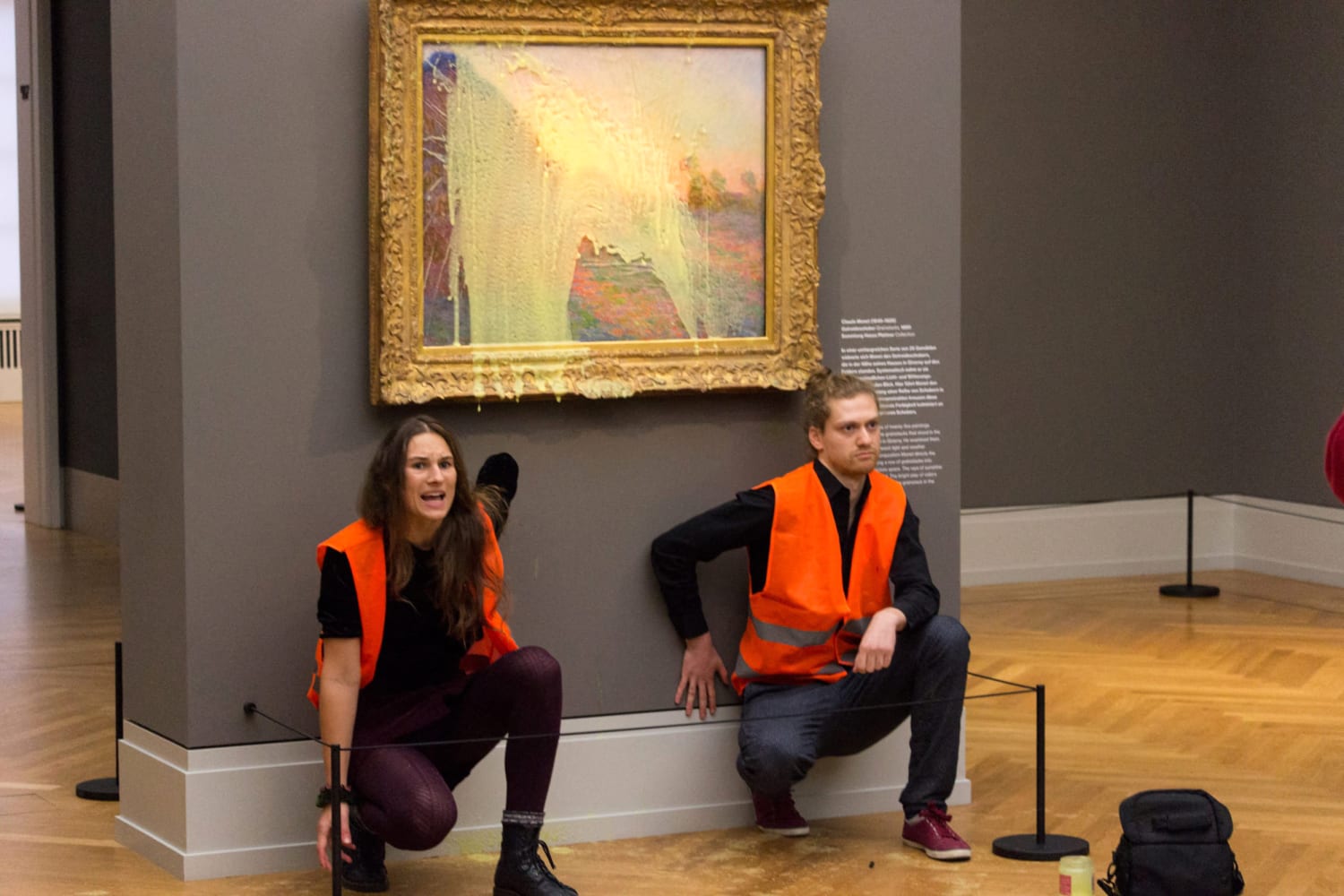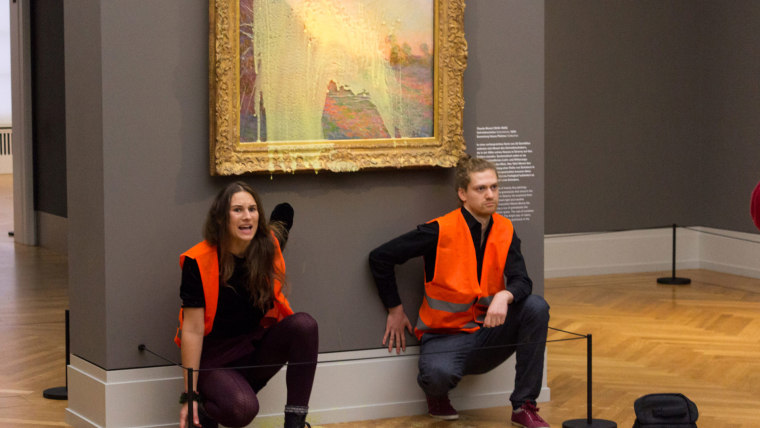On Sunday, two climate activists hurled mashed potatoes at “Les Meules,” a valuable Claude Monet painting in a German museum. The agitators glued themselves to the wall beneath the artwork for extra measure. It was the latest stunt from Last Generation, a German climate group that is calling for the government to take action to stop using fossil fuels.
The disruption is one of many in a series of protests in which environmental advocates from various organizations target iconic paintings by celebrated painters.
If climate activists focused only on symbols directly related to what is damaging the planet — like a pipeline or an oil refinery — then it may not have gotten quite the same buzz. It would’ve been too predictable.
In May 2022, for example, an activist smeared a pastry across the Mona Lisa in Paris’ Louvre Museum. Two months later, demonstrators glued themselves to the frame of Leonardo da Vinci’s “The Last Supper” and spray-painted the wall below it at London’s Royal Academy of Arts. Earlier this month, activists tossed tomato soup at “Sunflowers,” one of Vincent van Gogh’s most famous oil paintings, at the National Gallery in London.
These attention-seeking actions are designed to raise awareness of the climate crisis.
Pundits argue that the motivation behind this organized chaos, particularly because the artwork themselves have nothing to do with the climate, is “daft” and idiotic. But they couldn’t be more wrong.
If climate activists focused only on symbols directly related to what is damaging the planet — like a pipeline or an oil refinery — then it may not have gotten quite the same buzz. It would’ve been too predictable.
Generating headlines — which these activists are doing in spades — is critical for advancing decarbonization policy at this point in time. This is because of the importance of “agenda setting.” While media coverage of the soup, mashed potato or pastry incidents may not change the minds or behaviors of climate deniers (although, as my research shows, there is some evidence that it can), it does increase the relevance of the issue in the eyes of the public.
As political scientist Bernard Cohen noted in 1963, “the press may not be successful much of the time in telling people what to think, but it is stunningly successful in telling its readers what to think about.”
And shifting what the public thinks about is crucial for those seeking to prompt positive change. It’s part of the process of shifting the “Overton window,” the range of policies that are politically acceptable to the mainstream population at a given time. In the United States, it was once the case that the idea of granting women the right to vote was considered fringe. Now, it’s common sense. This reflects progress in shifting the Overton window toward providing more rights for more people. In order to shift the public’s conception of acceptable climate policies, it’s essential the media cover the issue in a big way.
For decades, topics concerning the climate crisis were shrouded in obscurity within academic journals and conferences. But recently, we’ve seen a push for more journalists to cover the climate crisis.
Data from the Media and Climate Change Observatory — an international, multi-university collaboration at the University of Colorado Boulder that monitors coverage of climate change — found that U.S. coverage of the topic reached a historic high last year. At the same time, global coverage was the highest it had been since 2009.
“Climate change is no longer just a science story,” said Max Boykoff, lead project investigator for the observatory. “It’s now a political, economic, societal and cultural story.”
Of course, a significant part of that is because more people see, in real time, the consequences of an overheating planet and concerns are growing, but we shouldn’t underestimate disruptive activism’s role in propelling this coverage. After all, when something unexpected happens, the media will cover it.
Still, some environmentalists argue that acts like these are counterproductive. Following the soup-throwing incident, Dr. Jonathan Foley, a scientist who leads the climate solutions group Project Drawdown, tweeted “No matter the motive, damaging or destroying shared cultural treasures in the name of saving the planet is a mistake.” Francois Gemenne, a lead author on the U.N.’s Intergovernmental Panel on Climate Change, tweeted that this kind of protest is “likely to antagonize public support for climate action.”
But that may be shortsighted because according to a 2021 United Nations Development Programme’s global poll that covered 50 countries and had 1.2 million respondents, a majority of people believe climate change is an emergency and support mitigation policies. I doubt that stunts to bring more awareness to the fact that people are living through widespread droughts, rising sea levels and extreme weather will suddenly cause support for steps to address these devastating events to drop.
If Monet, da Vinci and van Gogh were alive today, they should be glad that their works are raising awareness for an important cause. Their paintings are fine (unharmed, according to the museums). The climate, however, may not be. And activists need to keep working as we are running out of time to solve the crisis.
Source: | This article originally belongs to Nbcnews.com










